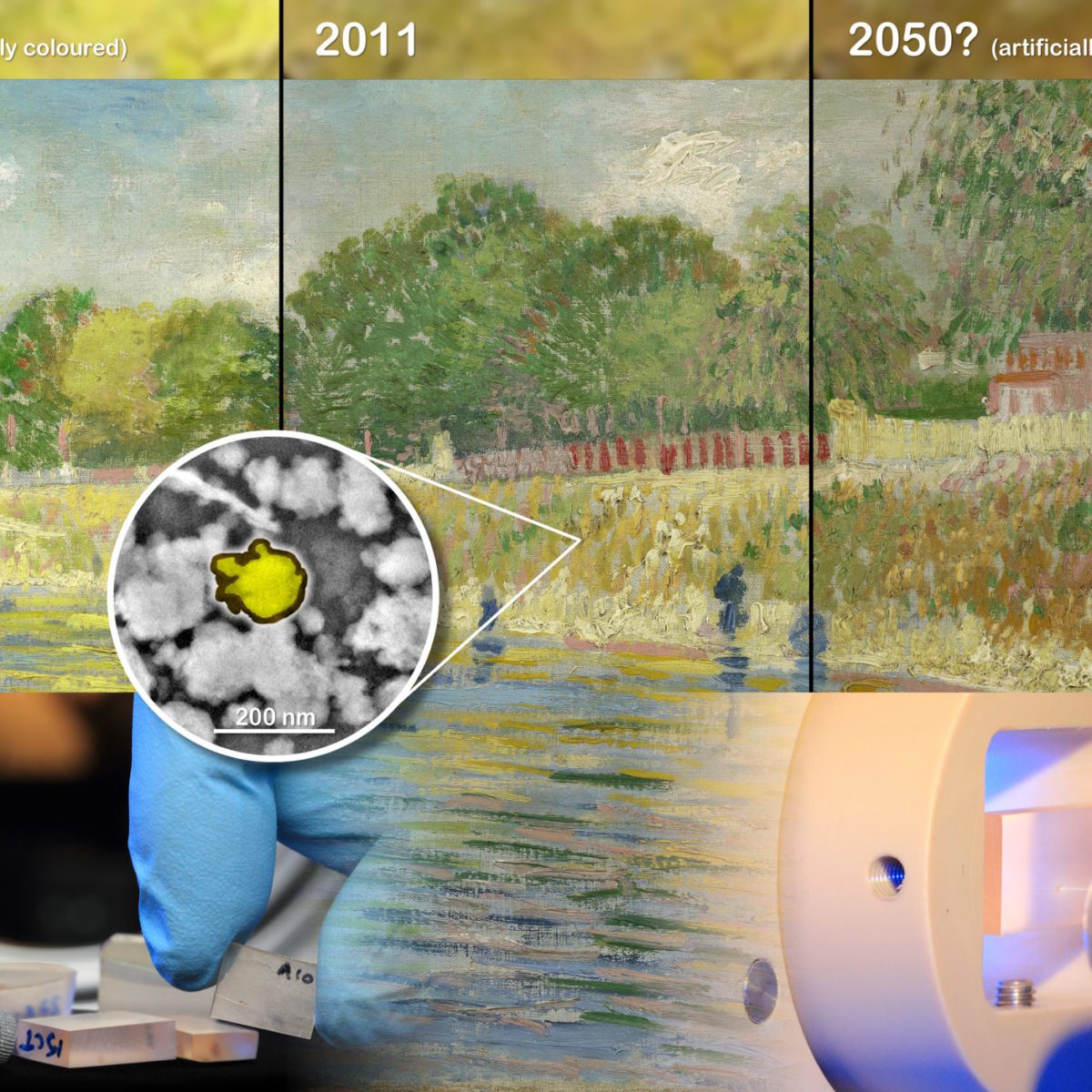
Uncaptioned version of simulated past, present and future aspect of ‘Bank of the Seine’ (V. Van Gogh, 1887)
Synchrotron radiation has become a powerful tool for studying unique ancient artifacts such as works of art and fossils.
Synchrotron radiation has become a powerful tool for studying unique ancient artifacts such as works of art and fossils. In the last decade, the structures of these historical materials have been revealed on a micro and nanometric scale, helping a variety of areas to understand the past and to learn how to preserve these relics.
During the 21st International Congress on X-Ray Optics and Microanalysis (ICXOM21) held in Campinas from the 5th to the 8th Sep 2011, three important researches demonstrated how the use of synchrotron radiation can contribute to knowledge in the fields of Arts, History and Paleontology. The congress was organized by the Brazilian Synchrotron Radiation Laboratory (LNLS).
Scientist Marine Cotte, holder of a PhD in chemical compounds used in ancient times, explains how the non-invasiveness of synchrotron radiation, allied to its chemical sensitivity, allows for in-depth analyses of complex multilayered materials such as works of art. Using techniques such as X-ray absorption spectroscopy (XAS), it is possible to obtain information about the chemical state and local composition of analyzed objects, and to identify chemical elements that are harmful to them.
The use of this technique can reveal two “histories.” The first goes back to the time when the work of art was produced. One can, for instance, observe the different layers of paint and identify all the substances that make up their pigments. This may enable a better understanding – or even the reconstitution – of techniques employed by ancient artists, preserving the heritage of a culture. The second history is current and has to do with the advances in the forms of restoration and conservation of these works of art: knowing the chemical composition of these pigments enables one to avoid undesirable reactions or to identify those that preserve the work of art.
In the same context, Professor Koen Janssen, holder of a PhD in chemistry, analyzed the degradation of the yellow color in the paintings of Dutch painter Vincent Van Gogh. Using synchrotron radiation, Janssen was able to observe on a nanoscale the formation of chromium oxide around the original pigments, denoting aging of the paint.
In the opinion of this researcher, the use of synchrotron radiation enables micro and nanoscale analysis, and may lead to distinct conclusions. On the nanometric scale, it may be useful for enabling restorers to identify the chemical elements that emerged in paints and why they were mixed with the original pigment. On a micro scale, it is possible to see the layers hidden by the paint, highlighting the tracings of the painter. Historians can use this type of analysis to compare the evolution of painting techniques and to check the originality of works of art.
3D imaging in Paleontology
Another approach in research using synchrotron radiation may contribute in the solving of a puzzle which still lacks many pieces. In the field of paleontology, where information is scattered in isolated specimens, it is difficult to find the lost links in the evolutionary chain. For researcher Isabelle Kruta, of the Peabody Museum of Natural History at Yale University in the U.S., the use of 3D imaging has proved to be an excellent solution.
An article recently published in the journal Science showed a digital reconstitution of the jaw of a mollusk fossil of a species Baculites. This 3D model could only be built using the techniques of tomography allied with synchrotron radiation on shell fossils and tooth-vestiges of this species. In one of these specimens, the researchers found encrusted remains of plankton, indicating that the animal died during its last meal.
For Kruta, this type of analysis helps scientists find vestiges and substances that are invisible to the naked eye. This may lead to discoveries about the relationship between organisms, representing a deeper step in the study of Ecology.
The 21st edition of the International Congress on X-Ray Optics and Microanalysis (ICXOM21), the first held in Latin America, was attended by 150 researchers from many parts of the world. “Brazil was chosen because it is the only country in the continent that has a synchrotron radiation source. In addition to developing basic and applied research in X-day optics at the vanguard of knowledge, LNLS began a project for the construction of a new synchrotron radiation source – Sirius – which will provide the community of Brazilian and Latin American users access to new techniques for scientific exploration and enable the national development of scientific instrumentation and new technologies with a new level of complexity,” states Carlos Perez, coordinator of the Congress.
Impact: Jornal da Ciência (Journal of Science) – Download the printed edition of the Jornal da Ciência No. 698
An interview with Jean René Regnard, one of the creators of the Higher European Research Course for Users of Large Experimental Systems
Brazil expects Argentina’s collaboration in the construction of a new synchrotron light source. The Argentineans are the main foreign users of the laboratory.